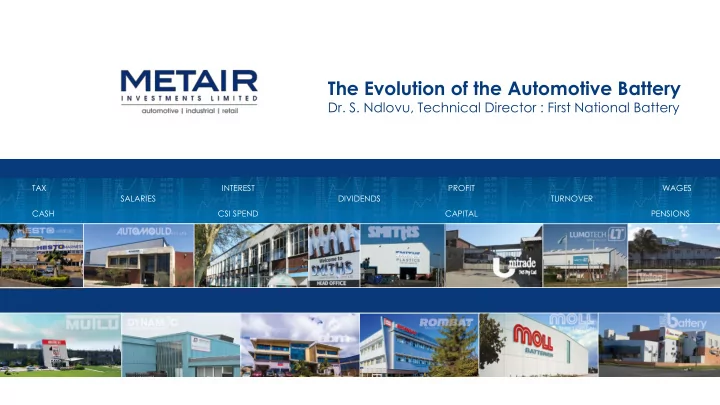

The Evolution of the Automotive Battery Dr. S. Ndlovu, Technical Director : First National Battery TAX INTEREST PROFIT WAGES TAX INTEREST PROFIT WAGES SALARIES DIVIDENDS TURNOVER SALARIES DIVIDENDS TURNOVER CASH CSI SPEND CAPITAL PENSIONS CASH CSI SPEND CAPITAL PENSIONS
PRESENTATION OVERVIEW • The lead-acid battery • Lead – acid battery development • Key innovation drivers • Shift to Li-ion 2
Pb-ACID BATTERY CHEMISTRY 3
Pb-ACID BATTERY CHEMISTRY 4
AUTOMOTIVE BATTERY HISTORY • Car batteries became widely used around 1920 as cars became equipped with electric starters • Cars used 6V electrical systems and batteries until the mid-1950s. • The changeover from 6 to 12V happened when bigger engines required more electrical power to start STARTING LIGHTING IGNITION 5
SLI BATTERY GRID ALLOY DEVELOPMENT HIGH MAINTENANCE Low Antimony Calcium • Low Sb positive, • Strong Ca negative • Good cycling • Good cycling • Very low water • Water loss lower ability ability loss than low • High water loss • Lower water loss antimony Antimony Hybrid Alloy LOW MAINTENANCE 6
GROWING ENERGY REQUIREMENTS IN THE CAR Developments in 1980s – 1990s required more electrical power • Reduced exhaust emissions • Better fuel economy • Improved safety • Increasing comfort and convenience - seat warmers, entertainment systems, air conditioners etc. • Premature ageing due to acid stratification and inhomogeneous current distribution FURTHER DEVELOPMENT NEEDED 7
START- STOP SYSTEM CONTINUED START-STOP SYSTEMS ENTER THE MARKET STANDARD VEHICLE START STOP VEHICLE START STOP 1, 500 Engine starts P/A* 17, 500 * Based on 15 000 km P/A of CBD travel KEY CHALLENGES: CHARGE ACCEPTANCE, CYCLE LIFE 8
AGM BATTERY TECHNOLOGY Glass mat separators KEY FEATURES Recombinant lid technology and Higher pack pressures to facilitate improved cyclic lifespan. ABSORBENT GLASS MAT 9
AGM BATTERY ADVANTAGES AGM has very low internal resistance & high charge acceptance • Perfect for advanced start-stop systems in which the battery needs to be quickly recharged, through • the energy provided by the regenerative braking system Capable to deliver high currents on demand and offers a long service life • AGM is maintenance free, non-spillable • 3x the endurance of conventional batteries • ONLY SOUTH AFRICAN AGM BATTERY SUPPLIER 10
EFB TECHNOLOGY Carbon additives in the plate manufacturing process. • Improved cycling performance compared to conventional • flooded batteries. Support for a high number of engine starts and extended • engine-off periods. Improved charge acceptance compared to conventional • flooded batteries. Lower tier option to AGM batteries Suitable for entry level start-stop vehicle technologies. • ENHANCED FLOODED BATTERY 11
Pb-ACID BATTERY COMPARISON SLI EFB AGM Maintenance-Free • Low Maintenance • Maintenance Required • Immobilized electrolyte • Free flowing electrolyte • Free flowing electrolyte • For start-stop and advanced • For start-stop applications • Conventional • applications Improved Charge Acceptance • applications Rapid/Dynamic charge Up to 25% increased cranking • • power acceptance 120 Cycles @50% DOD • 240 Cycles @ 50% DOD • Higher cold cranking • Economical • 2x improved life cycle • performance – 35% improvement Lower tier option to AGM • 360 Cycles @50% DOD • batteries 3x improved life cycle • INCREASING BATTERY PERFORMANCE 12
CARBON DIOXIDE EMISSION TARGETS
PRODUCT TRENDS – ELECTRIFICATION IN CARS
SIX KEY DRIVERS OF E-MOBILITY 15
MOVE TO HIGH VOLTAGE BATTERY REQUIREMENTS 6 V 12/24 V 48 V >300 V 16
WHAT IS A LITHIUM ION BATTERY? 17
DIFFERENT LITHIUM ION CHEMISTRIES 18
ENERGY DENSITY OF DIFFERENT BATTERY SYSTEMS • High energy density • Size & Weight Advantages • Peukert’s Losses & Voltage Sag – virtually non-existent 19
LI-ION BATTERY CELL DESIGNS CYLINDRICAL CELLS PRISMATIC CELLS POUCH CELLS 20
PROS & CONS OF LI-ION VS LEAD-ACID BATTERIES High energy density Expensive • • Relatively low self-discharge Transportation problems • • Low maintenance Needs Circuit Protection • • protect from over-charge & over- › Size & Weight Advantages • discharge Superior useable capacity Safety risk • • Poor recycling • Extended cycle life • Immature te c hnology • Fast and efficient charging • Deep Discharge • Very little wasted energy • 21
DECREASING COST OF LI-ION TECHNOLOGY 22
COST OF LI-ION vs LEAD-ACID TECHNOLOGY INITIAL COST PER BATTERY CAPACITY TOTAL LIFE CYCLE COST Flooded Flooded EFB EFB AGM AGM Lithium-ion Lithium-ion Cost per Battery Cost Per KW LI-ION: COMPETITIVE LIFE CYCLE COST 23
CONCLUSION Pb- Acid is here to stay but…Li -ion is the technology of the future! 24
THANK YOU
Recommend
More recommend